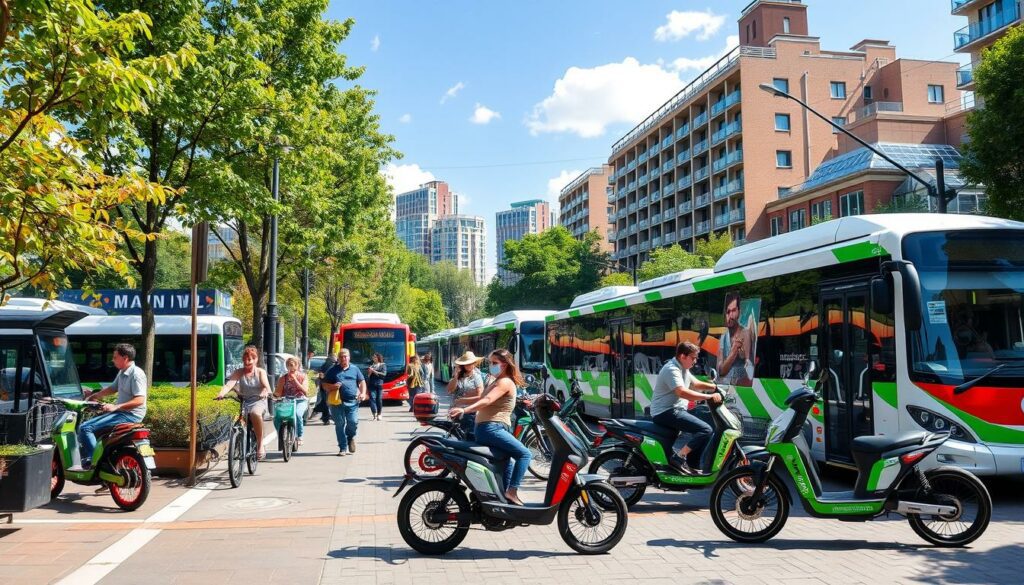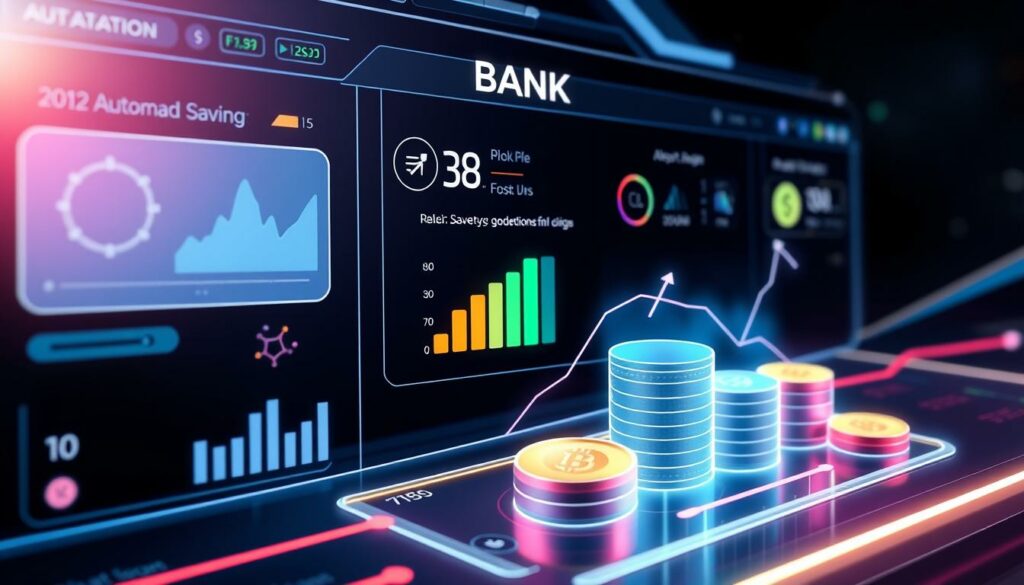How to Save Money in 2024: 50 Practical Tips

Table of Contents
Did you know the U.S. personal saving rate has dropped to 3.5% as of March 2024? This is a big fall from 26.1% just three years ago1. With living costs going up and interest rates high, saving money is more important than ever. With *average rent* for a one-bedroom at $1,534 and grocery prices up 8.4% in 2022, budgeting is key1.
I think we can get through these tough times with smart financial planning and careful spending. It’s all about making the right choices with our money.
In this guide, I’ll share 50 *practical tips* for saving money in 2024. We’ll cover why saving is important and how to make a budget that works. Each tip is aimed at helping you manage your finances better. By following these strategies, I hope you’ll feel more in control of your money and your future.
Key Takeaways
- Personal saving rates are critically low, emphasizing the need for saving strategies.
- Average *monthly rent* and grocery expenses are rising, making budgeting crucial.
- Incorporating the 50-30-20 budgeting method can simplify your finances2.
- Saving at least three months’ worth of expenses can enhance financial security2.
- Utilizing high-yield savings accounts can benefit from competitive interest rates.
Understanding the Importance of Saving Money
Saving money is key to managing your finances well. It helps you have a safety net for unexpected costs. The Consumer Federation of America says that saving and spending plans are linked to keeping emergency funds3. This shows that saving can give you peace of mind and improve your financial knowledge.
Setting clear savings goals makes saving and investing easier. A good plan can make you feel happier about your money situation3. Experts also say that planning helps you feel in control, which boosts happiness and helps you handle stress better3.
Saving is more than just saving money; it’s about securing your future. A study found that 20% of people over 50 have no retirement savings, showing the importance of starting early4. Achievable short-term goals help build lasting saving habits, leading to bigger goals like retirement or education5.
I regularly check my spending to find ways to save more. This helps me save more by cutting down on unnecessary expenses. Joining in on events like America Saves Week motivates me to save more. Getting help from community resources, like newsletters from the Consumer Federation of America, keeps me on track with saving tips3.
| Aspect | Benefits |
|---|---|
| Savings Goals | Provides direction and motivation. |
| Emergency Fund | Offers a financial safety net. |
| Budget Review | Helps track spending and savings progress. |
| Automated Savings | Ensures consistent contributions to savings. |
| Community Resources | Provides support and increases financial knowledge. |
Creating a Sustainable Budget
Creating a sustainable budget is key for managing your finances well. I start by making a list of all my income and expenses. This helps me see where my money goes each month. It’s the first step towards better budgeting.
I often use the 50/30/20 rule. It says to spend 50% on needs, 30% on wants, and 20% on savings and debt. This way, I can save for the future while still enjoying life today6.
Starting to save early is very beneficial. It means I can put away smaller amounts that grow over time7. I always save first, making it a must-do before spending on other things. I also set up automatic savings for my retirement, which can even get matched by my employer7.
Having an emergency fund is also important. I aim to save enough to cover six months of expenses7. It’s vital to review and adjust my budget as my life changes, like when I get a new job or move7. Knowing about tax-advantaged accounts helps me save more efficiently, opening up better investment options. Here’s a table showing different budgeting methods I look at:
| Budgeting Method | Description |
|---|---|
| 50/30/20 Rule | Allocates 50% to needs, 30% to wants, and 20% to savings. |
| Zero-Sum Budget | Assigns every dollar a job, total income equals total expenses. |
| Anti-Budget | Prioritizes savings first and allows free spending on remaining funds. |
| Money Flow System | An automated setup that minimizes maintenance after initial setup. |

By following these steps, I can make a budget that helps me financially now and in the future.
Effective Budgeting Tips for Finance Management
Effective budgeting tips are key for managing your finances well. The 50/30/20 rule is a good starting point. It suggests using 50% for needs, 30% for wants, and 20% for savings or debt. This method has helped me save more since I started using a realistic budget8.
Implementing the 50/30/20 Rule
To follow the 50/30/20 rule, I regularly check my budget. This is to adjust for changing costs like holiday gifts or car fees. Keeping an emergency fund, equal to three to six months of income, helps with unexpected costs and avoids debt9.
Calling my budget a “spending plan” motivates me to manage my money better.
Using Budgeting Apps for Better Tracking
Budgeting apps make tracking my spending easy. They help me stay on top of my finances. By using these apps, I can automate payments and save more, which is good for my credit score8.
Using cash for big purchases also helps avoid debt. It keeps my financial goals within reach8.

| Budgeting Method | Allocation | Notes |
|---|---|---|
| 50/30/20 Rule | 50% Needs, 30% Wants, 20% Savings | Encourages balance between necessity and savings |
| Cash-Based Envelope System | Cash for Categories | Promotes conscious spending and limits overspending |
| Zero-Based Budgeting | Every Dollar Has a Purpose | Ensures income minus expenses equals zero |
Finding a budgeting method that fits me has been very helpful. Budgeting apps give me insights into my spending. This has made me more confident in my financial planning, leading to better financial health8.
How to Cut Down on Grocery Costs
Grocery costs can really hurt my budget. Making a grocery list before I shop helps me stay on track. It stops me from buying things I don’t need, which helps me save money. I plan my meals first, so I know exactly what I need for the week.
Making a Grocery List Before Shopping
Having a ready-made grocery list is key to saving money. It helps me shop smarter, buying only what I need. This way, I avoid spending too much. Shopping online is also a good idea, as it lets me compare prices easily without extra costs10. Plus, I try to shop when I’m not hungry, so I don’t buy more than I need.
Shopping Generic Brands for Savings
Choosing generic brands is a smart way to save. They’re often cheaper than name brands but just as good. By saving $2-3 on 20 items, I can cut down my grocery bills a lot. This means I can save more money for other things11.
Utilizing Coupons and Discounts
Using coupons and discounts is another great way to save. I join grocery loyalty programs to get discounts and points. I also compare prices at different stores to find the best deals10. Buying in bulk helps too, as it saves money and reduces waste.

Saving on Housing Expenses
Managing housing costs is key in any financial plan. These expenses usually take up the biggest part of my monthly budget. By using smart budgeting, I can lower these costs a lot. Here are a few ways I save on housing:
Negotiating Your Rent or Mortgage
Negotiating rent or mortgage is a smart move. Many landlords and lenders are willing to talk, especially if I show I’m a reliable tenant. With new home prices over $400,000 in the U.S., it’s crucial to negotiate12. I present my case with market trends or my payment history to get lower payments.
Consider Getting a Roommate
Getting a roommate is another good idea. Sharing the space means splitting costs, which helps a lot. Homeowners in the U.S. have 38 times more wealth than renters, making this strategy important12. Also, moving to a cheaper area can save even more money. For example, home prices vary from $375,800 in the Midwest to $785,300 in the Northeast12.

Reducing Utility Bills
Utility bills can really affect my budget. In 2022, the average electric bill in the U.S. was $137 a month, or about $1,600 a year13. To cut costs, I can lower my thermostat by 7 to 10 degrees for 8 hours. This can save around 10% on heating and cooling costs each year13.
Using energy-efficient appliances, like those with the Energy Star label, also helps save money. Switching to LED bulbs can save me about $225 a year13.
Turning off “vampire” appliances can save up to $200 a year14. Washing clothes in cold water can also save energy, as hot water uses a lot of it. Setting my fridge and freezer to the right temperatures and using an efficient showerhead can save even more13.

| Practice | Impact on Utility Bills |
|---|---|
| Adjusting Thermostat | 10% reduction in heating and cooling costs |
| Using LED Bulbs | $225 savings per year |
| Unplugging Appliances | Up to $200 savings annually |
| Washing in Cold Water | Lower hot water costs |
| Maintaining Water Heater | 4%-22% reduction in energy costs |
These changes help me save money and manage my finances better. Keeping an eye on my electric bill will show how well these changes work13.
Transportation Cost-Saving Strategies
Transportation costs are a big part of my budget. Finding ways to cut these costs is key for good financial planning. Here are two strategies I use to save money on getting around.
Taking Public Transportation
Choosing public transport saves money and helps the planet. Studies show sea freight is cheaper than air, showing the value of different transport options15. Using buses or trains instead of cars saves on fuel and upkeep.
Public transit can cut costs by up to 20% and make deliveries more reliable16. It keeps my spending low and helps reduce traffic and pollution.
Carpooling with Friends or Coworkers
Carpooling is another way to lower travel costs. Sharing rides with others cuts fuel and parking costs, leading to more savings. For businesses, managing transport costs is crucial15. So, carpooling is good for my wallet and the environment.
Sharing a vehicle means less wear on roads and less pollution. It also strengthens my social bonds.

Ways to Save on Insurance Premiums
Insurance premiums can be a big monthly cost. Finding ways to cut these costs is key for managing your budget. One good way to save is by bundling different policies with the same company. This can lead to big discounts, as many insurers give lower rates for bundling home, auto, and other insurance types17.
Bundling Policies for Discounts
Many people miss out on savings by not bundling. When looking at insurance, I always check if I can bundle coverage types. Insurers often give discounts for bundling multiple types or vehicles, saving money over time17.
Shopping Around for Better Rates
Getting quotes from different companies is also important. I suggest getting at least three quotes to compare prices. Prices can differ by hundreds of dollars, so it’s key to shop around for the best deal17. Full coverage car insurance costs about $2,314 a year, while minimum coverage is around $64418.
Also, discounts are available for features that lower risks, like anti-theft devices or defensive driving courses. Keeping a good credit score also helps lower insurance costs, as many insurers use credit scores when setting prices17.

| Insurance Company | Average Premium |
|---|---|
| State Farm | $2,364 |
| Geico | $1,741 |
| Progressive | $1,988 |
| Allstate | $2,971 |
| USAA | $1,695 |
In conclusion, by bundling policies and comparing rates, I can save a lot. This helps me in my journey towards better financial services and keeps my budget balanced1718.
Financial Planning for Retirement
Planning for retirement means taking the right steps to secure my financial future. Setting up retirement accounts like a 401(k) or IRA can really help my savings grow. In 2024, the IRS allows up to $23,000 in 401(k) contributions, with an extra $7,500 for those over 5019.
For traditional IRAs, the limit is $7,000, with a $1,000 boost for those 50 and older19. Roth IRA contributions are the same, but there’s a phase-out for those earning between $146,000 and $161,000 a year19.
Setting Up a 401(k) or IRA
Employers might match my contributions, which can really increase my savings19. Starting early is key, as only half of Americans have figured out how much they need for retirement20. By using retirement plans and employer matches, I can use compound interest and tax deferrals to grow my savings over time20.
Automating Your Savings Contributions
Automating my retirement account contributions means I save without having to think about it. This way, I avoid penalties or losing benefits from early withdrawals20. As I get closer to retirement, I need to switch from saving to planning how to use my funds19. A good retirement budget should cover housing, healthcare, food, and more for a comfortable retirement19.

Investment Management Strategies
Effective investment management is key to growing my wealth. Regularly reviewing my portfolio is crucial for financial health. Rebalancing keeps my asset allocation in line with my risk-return goals21.
Diversification spreads my investments, lowering risk21. Knowing my risk tolerance helps me choose wisely.
Research shows investors use different strategies, from active trading to buy-and-hold21. Getting advice from a financial advisor can help tailor my strategies to my goals. Advisors use metrics like the Sharpe Ratio to evaluate investments21.
I’ve looked into various strategies, like income investing for retirees22. Dollar-cost averaging helps manage market volatility22. Monitoring beta helps assess risk21.

| Investment Strategy | Description | Ideal For |
|---|---|---|
| Income Investing | Aims to produce a steady income stream. | Investors transitioning into retirement |
| Dollar-Cost Averaging | Spreads purchases out over time to reduce market volatility impact. | Risk-averse investors |
| Value Investing | Involves purchasing undervalued stocks for long-term gains. | Investors looking for growth potential |
| Socially Responsible Investing | Aims to create societal change while generating returns. | Ethical investors |
In conclusion, sound investment management is vital for my financial well-being. By using various strategies and learning about investment principles, I can achieve my financial goals with confidence.
Debt Consolidation for Improved Financial Health
Managing debt well needs a smart plan, and debt consolidation is a top choice. It combines many debts into one easy loan or payment. This makes tracking easier and can lower interest costs, helping with monthly payments23.
When picking a plan, I look at my debts to find the best fit for my goals.
Choosing the Right Consolidation Plan
Choosing the right plan means looking at a few things. I check my current debts and their interest rates. For example, credit cards average 20.70 percent, while personal loans are about 12.43 percent24.
Going for a lower rate can save a lot on interest over time. Balance transfer cards offer 0% APR for 12 to 21 months, great if I can pay off quickly2325.
It’s also key to think about my credit score. Payment history is 35 percent of my score, and managing this loan can help improve it24. But, not all plans boost credit right away; some may even lower it temporarily23.
So, I make sure my payments are no more than 50% of my income before starting25.

Success in debt consolidation comes from making timely payments. This improves my credit history. Creating a budget that fits my new payments is crucial for staying financially stable.
| Consolidation Method | Interest Rate Range | Potential Benefits | Considerations |
|---|---|---|---|
| Debt Consolidation Loan | 6% – 36% | Lower monthly payments, fixed terms | Approval may depend on credit score |
| Balance Transfer Credit Card | 0% for initial period | No interest if paid within promotional period | Requires higher credit score to qualify |
| Debt Management Plan | N/A | Lower overall payments, professional guidance | Enrollment may impact credit score |
By weighing my options and picking a plan that fits my financial goals, I’m on my way to being debt-free242325.
The Role of Financial Literacy in Saving Money
Financial literacy is key to managing money well. It helps me make smart choices about saving and budgeting. Without it, handling money can feel overwhelming and stressful.
Studies show only 19% of millennials with high finance knowledge get basic questions right26. This highlights a big knowledge gap that affects our financial decisions.
To build financial literacy, I need to learn from various sources. Schools and universities teach the basics of money management27. Online platforms and apps also offer learning options for different people.
By using these resources, I can learn important financial concepts. This leads to better financial choices over time.
Many studies show financial literacy reduces stress and anxiety. Knowing key financial ideas improves my financial health28. Professional advisors can also offer personalized advice, helping me save and invest better.
Sharing knowledge with others and joining financial literacy groups can also help. This way, I can learn more and use effective budgeting strategies27.

Utilizing High-Yield Savings Accounts
In my financial planning, I’ve found high-yield savings accounts key for saving money. They offer much higher interest rates than regular savings accounts. This means my savings can grow faster. In fact, they can earn up to 15 times more than a standard savings account29.
Also, in 2024, high-yield savings accounts have an average interest rate of 0.50% APY. This makes them even more appealing30.
Comparing Different Savings Account Rates
When looking at different high-yield savings accounts, it’s important to consider a few things. These include interest rates, how much you need to start, and any fees. For instance, if I put $5,000 in an account with a 4.50% APY, I’d earn $229 in interest. But a traditional account with a 0.46% APY would only earn $23.0529.
Customers save 2.3 times more with high-yield savings accounts than with regular ones30. It’s crucial to check if the account fits my financial goals. Also, some high-yield accounts might not have checking accounts, so I need to plan carefully29.
High-yield savings accounts have many benefits. They help keep savings separate from daily spending, which can prevent impulse buys. They also offer deposit insurance for safety. However, there are downsides like possible withdrawal limits and changing interest rates. Online banks often have the best rates. Since 32% of people use these accounts as their main savings, it’s important to stay updated on options for 202430.

Automating Your Saving Process
Automating savings is a key to reaching my financial goals easily. It lets me set automatic transfers from my checking to savings. This way, I avoid spending too much. Savings accounts help me stay disciplined with my budget31.
I can tailor my savings plan for different goals, like an emergency fund or retirement32. For example, saving $100 a week automatically has worked well for many, like Melanie Lockert32.
Starting to save early in my career is crucial. It helps grow my savings through compound interest. This encourages me to save as soon as I can.
There are two main ways to automate savings: account transfers and direct deposits. By setting the amount and frequency, I create a consistent saving habit32. Online-only banks often offer better interest rates than traditional banks, which is good for my savings31.
I also do regular financial check-ups to adjust my savings plan. This keeps my savings growing while covering my daily needs. Automating my savings has greatly improved my financial management and future savings.

Incorporating Savings Challenges into Your Routine
Joining saving challenges can help me think differently about spending. These challenges help me plan my finances better. For example, the ‘No-Spend Day’ challenge helps me save by only buying what I need.
By doing this, I learn to control my spending and avoid unnecessary costs. It makes me more mindful of how I spend my money.
Setting Up a ‘No-Spend Day’ Challenge
The ‘No-Spend Day’ challenge helps me avoid buying things I don’t need. It’s a chance to review my spending and find new ways to use what I already have. I might try the 26-week challenge, saving 26% of my income for six months33.
Or, I could try the 52-week challenge, saving a little more each week. Starting with $1 and saving $1,378 by the end of the year is a goal34. Both challenges help me improve my financial planning and budgeting.
I could also try the envelope challenge. It can save me between $465 and $4,095, depending on how long I stick with it35. These challenges not only help me save money but also improve my financial health.

Conclusion
In 2024, saving money is key, not just a goal. It needs a strong base of financial planning and discipline. By using the tips from this article, I can better manage my money. This helps me save more and improve my financial health.
Creating a budget and watching my spending are crucial. Learning about money is also important. These steps help me reach my financial goals.
Financial education is vital, as shown by many programs36. Applying what I learn daily is essential. It’s not just about making money but understanding it too. This builds lasting security.
My financial journey is ongoing. I regularly check my spending and saving. This keeps me on track.
Staying committed to making smart choices is important. The world of money changes, and being open to new ideas helps. Being persistent and proactive will secure my financial future3738.
FAQ
Why is saving money important?
Saving money helps you achieve financial stability and freedom. It acts as a safety net for unexpected costs. It also reduces your need for credit and aids in reaching long-term goals.
What is the 50/30/20 rule in budgeting?
The 50/30/20 rule divides your income into three parts. 50% goes to needs, 30% to wants, and 20% to savings and debt. It’s a simple way to manage your finances well.
How can I cut grocery costs?
To cut grocery costs, make a detailed list before shopping. Choose generic brands and use coupons and discounts. These steps can greatly reduce your grocery bills.
What are some effective ways to reduce utility bills?
Lower utility costs by using energy-efficient appliances. Turn off devices when not in use. Regularly check your water and heating systems to avoid leaks.
How can I save on transportation costs?
Save on transportation by using public transport or carpooling. This reduces costs and lessens reliance on personal vehicles.
What should I consider when planning for retirement?
Setting up a 401(k) or IRA is key for retirement savings. Automating your savings makes it easier to prioritize without constant effort.
How does debt consolidation improve financial health?
Debt consolidation simplifies payments and may lower interest rates. It combines multiple debts into one, making it easier to manage.
What role does financial literacy play in saving money?
Financial literacy helps you understand personal finance and budgeting. It promotes effective money management and increases savings.
How can high-yield savings accounts benefit me?
High-yield savings accounts offer higher interest rates than regular accounts. They help grow your savings through compound interest. Comparing rates can help you find the best option for your goals.
What are some tips for automating my savings?
Set up automatic transfers from checking to savings. Banks offer features like rounding up purchases or saving change. These make saving easier and more convenient.
What is a ‘No-Spend Day’ challenge?
A ‘No-Spend Day’ challenge is a savings strategy. It encourages limiting purchases to essentials for a day. It helps you become more aware of your spending and motivates saving.
Source Links
- https://finance.yahoo.com/personal-finance/how-to-save-money-193015616.html
- https://www.npr.org/2024/01/02/1196978471/how-to-update-your-budget-to-cut-costs-and-save-more-money
- https://njaes.rutgers.edu/SSHW/message/message.php?p=Finance&m=122
- https://www.investopedia.com/articles/personal-finance/031215/why-saving-money-important.asp
- https://bettermoneyhabits.bankofamerica.com/en/saving-budgeting/ways-to-save-money
- https://www.moneymanagement.org/budget-guides/create-a-budget
- https://www.morganstanley.com/articles/creating-a-budget-your-guide
- https://www.fscb.com/blog/7-money-management-tips-to-improve-your-finances
- https://www.nerdwallet.com/article/finance/budgeting-tips
- https://www.ramseysolutions.com/budgeting/ways-to-save-on-groceries?srsltid=AfmBOor1jrKQcCuZS9SYOD7e0kOJgyObAUCrOYyeJ1kq9knNc4OSTQW7
- https://www.bankrate.com/banking/savings/ways-to-save-money-on-groceries/
- https://www.investopedia.com/articles/investing/092815/where-should-i-keep-my-down-payment-savings.asp
- https://www.nerdwallet.com/article/finance/how-to-save-money-on-your-electric-bill
- https://www.fidelity.com/learning-center/smart-money/how-to-lower-utilities
- https://www.smartteh.eu/en/blogs/reduce-transportation-cost
- https://www.invensis.net/blog/strategies-to-reduce-logistics-transportation-costs
- https://www.iii.org/article/how-can-i-save-money-auto-insurance
- https://www.bankrate.com/insurance/car/savings/
- https://www.investopedia.com/terms/r/retirement-planning.asp
- https://www.dol.gov/sites/dolgov/files/ebsa/about-ebsa/our-activities/resource-center/publications/top-10-ways-to-prepare-for-retirement.pdf
- https://www.investopedia.com/terms/p/portfoliomanagement.asp
- https://www.nerdwallet.com/article/investing/investment-strategies
- https://www.experian.com/blogs/ask-experian/pros-and-cons-of-debt-consolidation/
- https://www.bankrate.com/personal-finance/debt/pros-and-cons-of-debt-consolidation/
- https://www.nerdwallet.com/article/loans/personal-loans/what-is-debt-consolidation
- https://www.investopedia.com/terms/f/financial-literacy.asp
- https://www.forbes.com/sites/truetamplin/2023/09/21/financial-literacy–meaning-components-benefits–strategies/
- https://www.experian.com/blogs/ask-experian/what-is-financial-literacy-and-why-is-it-important/
- https://www.investopedia.com/articles/pf/09/high-yield-savings-account.asp
- https://finance.yahoo.com/personal-finance/how-to-use-a-high-yield-savings-account-183827481.html
- https://www.bankrate.com/banking/how-to-automate-your-savings/
- https://www.synchrony.com/blog/banking/how-automatic-savings-can-help
- https://www.moneylion.com/learn/savings-challenge/
- https://www.edvisors.com/blog/having-fun-saving-money/
- https://insights.valley.com/managing-your-money/article/10-savings-challenges-for-a-financial-glow-up/
- https://toolkit.nefe.org/evaluation-resources/evaluation-perspectives/conclusion
- https://www.mjcpa.com/whats-the-difference-between-a-calculation-of-value-and-a-conclusion-of-value/
- https://academic.oup.com/book/26923/chapter/196042170






